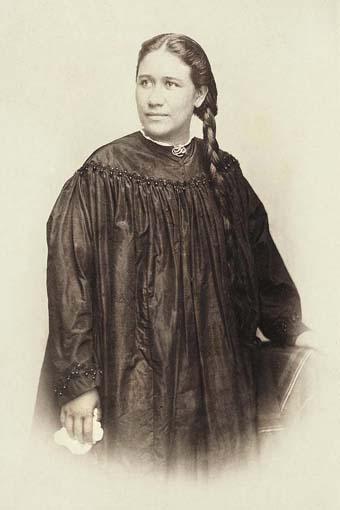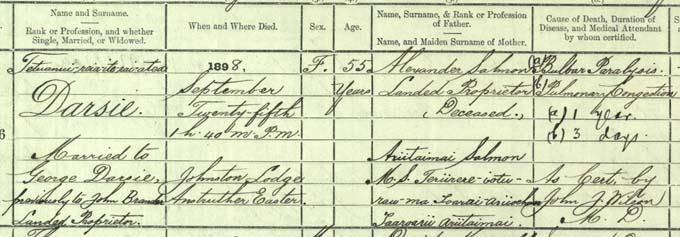At 1.40pm, on Sunday 25th September 1898, Princess Titaua, a member of the Tahitian royal family, died in her home, Johnston Lodge in Anstruther Easter. The wife of a local Justice of the Peace and landed proprietor, George Darsie, the Princess had lived in Scotland for five years before succumbing to ill health and passing away aged 55 years old. But how did a Tahitian Princess find her way to Scotland over 9,000 miles from her homeland?
Princess Titaua Marama of Tahiti was born into the Royal House of Tahiti, the royal line of Pomare, on 3rd September 1842, in Papetoai, Moorea, in the Society Islands, an archipelago in the South Pacific Ocean. Her parents were Princess Arrioehau, the sister of Queen Pomare IV of Tahiti, and a wealthy Jewish Englishman, Alexander Salmon (originally Soloman).
Salmon was born in London, England, around 1820. His parents were John and Rebecca, greengrocers in Piccadilly. His grandfather, miniaturist painter Solomon Polack, was said to have told Alexander enticing and exciting tales of adventure in lands far away, encouraging him to leave a future of trading fruits and vegetables behind for travelling the seas (source). He arrived in Tahiti in 1841 and, after a brief courtship, married the Princess, receiving a special dispensation from the king as it was not customary for members of the royal family to marry people from outside the community. Salmon was given the title ‘Royal Husband.’
The couple named their daughter Tetuanui-reia-ite-raiatea (Titaua for short), which translates to ‘the great God whose power extends to the heaven of heavens’.

Princess Titaua Marama of Tahiti, c.1869-70.
Credit: Public domain image from Wikipedia. Photograph by Paul-Emile Miot.
As a young woman, Princess Titaua Marama, Chiefess of Ha’apiti, married Scotsman John Brander. Brander was born in Elgin, Scotland, around 1817. In his youth he left his homeland to embark in trade, building a considerable fleet of ships and a substantial fortune as he travelled the oceans to Tasmania, the Pacific Islands, South America and Australia. Whilst in Tahiti, Brander met the Princess’s father, Alexander Salmon, and, on 14th February 1856, he married Princess Titaua. Together, the couple had nine children, the first being born when Princess Titaua was only 15 years old, and another three following by the time she had turned 20. The marriage secured Brander’s position and business in Tahiti, buying up vast areas of land and establishing the biggest trading house in the South Pacific. Princess Titaua also carried a high social status, not just by being the wife of a wealthy trader but because, from 1857, she was the chief (or Marama) of the island of Moorea. This was a largely ceremonial, but important social position.
The couple received visitors to the island including: Robert Louis Stevenson; the Scottish travel writer and landscape painter Constance Gordon Cumming; and Queen Victoria’s second son, Prince Alfred, who gifted the Princess a ring and a turquoise and diamond pendant. Brander’s health was not robust, however, and he died at Fautaua, Tahiti, on 15th June 1877, leaving his wife a widow of 34 years old.
The following year, Princess Titaua married George Darsie. Darsie was born in Anstruther, Scotland, on 20th September 1841 to parents George, a tanner (a person who cures hides to produce leather) and Margaret Johnston Walker.

George Darsie’s birth entry
Crown copyright, National Records of Scotland (NRS), Old Parish Registers of Births, 402/ Anstruther Easter page 92
Darsie worked for Brander’s company but had become a wealthy businessman in his own right. The Princess and her husband went on to have three children together and, upon Darsie’s retirement in 1892, Princess Titaua and her five youngest children ‘left the sunny skies and palm groves of her native land for the land of the brown heath and shaggy wood and the bagpipes. Such is the irresistible power of the Caledonian race.’ (East of Fife Record, 7th October 1898). Princess Titaua had left Tahiti before, and visited Britain with her first husband where, after a three-month journey, the couple had resided for a time with John Salmon, a rabbi, in Hastings, England. They then travelled to spend time with Brander’s half-sister Lady Dunbar and her family in Elgin (source).
The Darsie family lived in Johnston Lodge, Anstruther, where the Princess adapted ‘herself with consummate tact to her new surroundings, has endeared herself to one and all in our community, and by her sympathy and benevolence made herself a centre of gracious influence and sweet charity.’ (East of Fife Record, 30th September 1898).

Detail from a page of the 1895 valuation rolls recording Johnston Lodge and other properties which were owned by ‘Mrs George Darsie’ (Princess Titaua). The Lodge was valued at £30 per year for taxation purposes.
Crown copyright, NRS, 1895 valuation rolls, VR3/4 page 17
Within five years of arriving in Scotland, the Princess developed ‘bulbar paralysis’. This condition is caused by damage to the lower cranial nerves from a brainstem stroke or tumour which can result in difficulty swallowing. Her death entry gives this as the primary cause of death alongside pulmonary congestion (a build-up of fluid on the lungs).


Princess Titaua’s death entry
Crown copyright, NRS, Statutory Register of Deaths, 1898, 402/16 page 9.
Princess Titaua’s funeral took place in Anstruther Easter Churchyard. The day was wet, however large crowds gathered to pay their respects with the town’s flag flown at half-mast. The service was conducted by the Reverend Gabriel Smith, Minister emeritus of the United Presbyterian Church, Anstruther, and the Reverend James L. Green, London, formerly Pastor of the Protestant Church in Tahiti, an old and close friend of the family. The coffin, constructed in silver mounted panelled oak, bore the inscription – ‘Princess Titaua Marama of Tahiti, Chiefess of Haapiti, aged 55 years. 1842-1898.’
Her estate was left in equal parts to her children from both marriages; her inventory details the money, lands and moveable objects that she owned both in Scotland and in Tahiti at the time of her death.

A page from Princess Titaua’s inventory
Crown copyright, NRS, Wills and Testaments, SC20/50/84 pages 780-781
Her husband lived for a further two decades, dying aged 77 on 5th April 1919. He was buried three days later on Tuesday 8th April.
The East of Fife Record, on Friday 30th September 1898, remembered the Princess in a tribute in the days following her death:
“To those who were honoured with the intimacy of her friendship her memory will prove an indelible and priceless possession. With her cultured mind and wonderful memory, her great charm and grace of manner, her tender and sympathetic heart, her large-minded clearness and charity of judgement, her swiftness of intuition, her crystalline simplicity combined with a bearing that may be described as regal, the inheritance of a royal race born to claim the homage and rule the destinies of men, with all this unique combination of qualities of heart and intellect, she won the regard, the homage, and the veneration of all who came under the magnetic sway of her personality.
She who thus died among us has closed her earthly career far from her native land of Tahiti, that land of sunlight and of flowers, which she loved with a deep and passionate affection.”